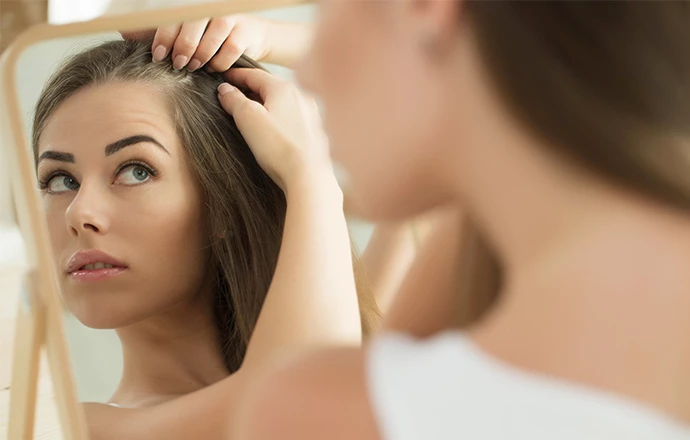Scratching Your Head? Refresh Your Scalp With Our Jargon-Buster
Seborrhea, psoriasis, tinea capitis – they’re all pretty tough to spell, and even tougher to diagnose. When it comes to your scalp, many issues could cause discomfort.
A lot of these problems are united by the same cause, and they’re more common than you might think. It’s very rarely a case of bad personal hygiene. Some of us are just unlucky – for example, we may produce too many naturally occurring oils.
If you want to understand your dandruff better, read our A-Z guide.

Atopic dermatitis
This is the most common form of eczema, a condition that causes dry, cracked and itchy skin. It is more common in children and these symptoms can appear on the scalp as well as the hands, insides of elbows, knees and face.
People with this condition may experience “flare-ups” and are more likely to have this if it runs in the family. You can treat atopic dermatitis with emollient creams or topical corticosteroids.
Contact dermatitis
Contact dermatitis is a skin reaction that may present as itchy, blistered, dry or cracked skin. It occurs when your skin is exposed to an allergen or an irritant. In the case of the scalp, this may be a reaction to a shampoo or hair product.
Cradle cap
This skin condition is most common in babies. It presents as skin flakes in areas with hair, or patches of greasy skin, red skin. In babies, it will most often clear up by itself, but adults may use medicated shampoos for seborrhoeic dermatitis.
Eczema
Eczema is a non-contagious skin condition that sometimes presents as scaly, itchy patches of skin. Atopic dermatitis is the most common form of eczema, whereby the immune system is affected and the skin is inflamed (dermatitis). Dandruff can be a symptom of scalp eczema.
Emollient cream
Emollient creams help to keep the skin supple and flexible for those suffering from eczema flare-ups. They contain fat and water that feels light and cool. They can be used on the arms, legs and body.
Impetigo
This skin condition is most common in children but can also present in adults. It’s caused by staphylococcus or streptococcus bacteria and can sometimes present as red, patchy areas. It can affect the scalp but appears as a yellow crust rather than dandruff flakes.
Inflammation
Inflammation is the body’s immune response to infection or injury. On the scalp, it may present as irritated or hot and painful areas.
Malassezia
Also known as Pityrosporum, Malassezia occurs naturally on the skin. It is a yeast that is usually harmless but can cause skin problems like dandruff if the body produces too much. It’s most common near the sebaceous glands, which produce oil – hence why it often presents on the scalp.

Parkinson’s
Parkinson’s disease is a degenerative disease. As it affects the immune system, Parkinson’s could be a risk factor for seborrhoeic dermatitis, which causes dandruff.
Psoriasis
Psoriasis is a skin condition that makes cells multiply faster than usual. It results in bumpy red patches and white scales. Psoriasis of the scalp may look like dandruff, but a key difference is that it presents as scales rather than flakes.
Sebum
Sebum is an oily substance that we naturally produce from our sebaceous glands. It keeps our hair and skin moisturised. A build-up of sebum can feed Malassezia yeast, resulting in dandruff.
Seborrhoeic
This relates to the sebaceous glands and refers to the overproduction of sebum, which can result in flaky skin or dandruff.
Seborrhoeic dermatitis
Seborrhoeic dermatitis is a skin condition on the scalp that causes scaly patches, red skin and dandruff. Typical causes are an overproduction of the naturally occurring yeast Malassezia, which may result in skin flakes.
Tinea capitis (ringworm)
Otherwise known as ringworm or dermatophytosis, this is a fungus that appears as ring-shaped lesions on the body. On the scalp, it can appear as itchy or bald patches. You may also notice brittle hair or painful scalp. It can be caused by Trichophyton, Microsporum, two types of fungus that can be handled by a range of treatments.
WHAT CAN YOU DO TO TREAT DANDRUFF?
Ketoconazole
Ketoconazole is sometimes one of the main ingredients of medicated shampoos, used to treat common conditions like dandruff and seborrheic dermatitis. It works by suppressing Malassezia, a yeast that naturally occurs on our skin. It’s available to buy as a shampoo.
Treating at the source
Some of the most common causes of dandruff, including the yeast Malassezia, can be treated with anti-fungal medication. With good hygiene, wise lifestyle choices and occasional topical treatments, you can say goodbye to these uncomfortable symptoms. Nizoral® is a medicated anti-dandruff solution that gets to the root of the problem.
Nizoral Dandruff 20mg/g Shampoo contains ketoconazole and is used to treat and prevent dandruff. Nizoral is only suitable for adults and adolescents from the age to 12 years. For external use only. Keep away from eyes. Always read the read label.

